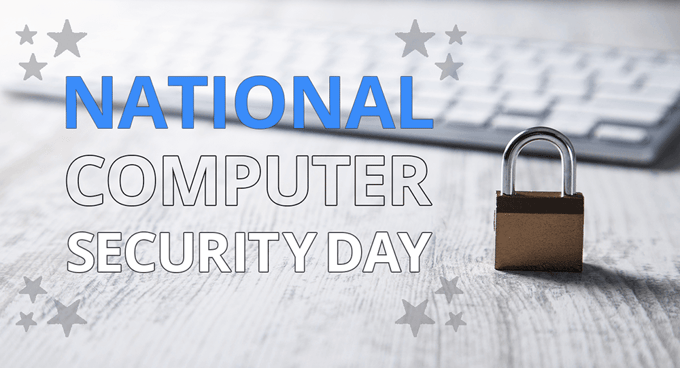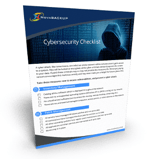Share this
National Computer Security Day is a Real Holiday!
by Sean Curiel on Nov 21, 2022 5:35:48 AM

The 1980s ushered in the era of personal computers into the homes of the average consumer. By the late eighties, they had become popular and even somewhat common in business and government agencies. With this monumental technology change, we also witnessed the birth of the original data security threats, such as hacking, worms, and simple viruses.
On November 2, 1988, Robert Morris, Jr., a graduate student in Computer Science at Cornell University, wrote the first worm, a self-replicating, self-propagating program. He chose to release it from MIT, to disguise its origin.
It was in 1988 when a worm discovered on the systems at Cornell University spread across multiple systems within hours via the ARPANET (an early forerunner of the Internet).
The world had become more connected, and proactive security measures would be required.
As a way to bring attention to this need, a chapter of the Association of Computing Machinery (ACM) created a National Computer Security Day to be recognized on November 30th.
So while some holidays like Cyber Monday (invented by the National Retail Federation) were created as commercial events, encouraging people to shop online, National Computer Security Day was born in response to an entirely new kind of data security threat. One that continues to grow in magnitude and complexity to this day.
The fact that consumers may be even more careless with their personal data around the time of peak online holiday shopping in America serves to further highlight the importance of recognizing National Computer Security Day. It’s something of a delightful coincidence that you can also nab some of the best data protection tools on the market for their lowest price at this exact time of the year.
How can this day help to serve us?
In this age, it’s not just System Administrators who must make ongoing efforts to secure infrastructure and data. Every one of us must regularly take precautionary measures with our networks, systems, software, and data. Unfortunately, it’s often the case that in the course of life, even the best of us can make mistakes. The truth of the matter is that a vast majority of attacks and threats can be blocked simply by following the security basics. NCSD is a great opportunity to check that our bases are covered.
- Multi-Factor Authentication (MFA) - Use wherever possible to enhance security
- Patching - Conduct regular patch management to correct vulnerabilities
- Passwords - Letters, numbers, and symbols, upper and lower case, 9+ digits long
- Antivirus - Updated and business class (rather than consumer) with real-time scanning
- Permissions - Employee access should adhere to the principle of minimal privilege (PoMP)
- Backup - Local and cloud backup of critical data, following 3-2-1 rule at a minimum
- Education - Can employees recognize obvious threats and respond appropriately?

To assist you, NovaBACKUP has constructed a Cyber Security Threat Prevention Checklist that can help guide you through all the foundational security steps that organizations should take. Review this list to see if your environment is vulnerable and set yourself recurring reminders for regular reevaluation.
With the checklist in hand, the November 30th date lingers as a deadline for securing our security.
And finally, the NovaBACKUP team is here with helpful recommendations on how to best secure your client environments. Simply request a call with one of our backup specialists.
Share this
- Pre-Sales Questions (91)
- Tips and Tricks (90)
- Industry News (37)
- Best Practices (36)
- Reseller / MSP (31)
- Security Threats / Ransomware (26)
- Disaster Recovery (24)
- Cloud Backup (22)
- Storage Technology (22)
- Compliance / HIPAA (20)
- Applications (18)
- Backup Videos (15)
- Virtual Environments (12)
- Technology Updates / Releases (7)
- Backup preparation (6)
- Infographics (5)
- Products (US) (4)
- Company (US) (1)
- Events (1)
- Events (US) (1)
- Unternehmen (1)
- December 2025 (2)
- November 2025 (1)
- October 2025 (2)
- September 2025 (1)
- August 2025 (1)
- July 2025 (1)
- June 2025 (2)
- May 2025 (2)
- April 2025 (2)
- March 2025 (1)
- February 2025 (2)
- January 2025 (2)
- December 2024 (1)
- November 2024 (2)
- October 2024 (1)
- September 2024 (2)
- August 2024 (1)
- July 2024 (2)
- June 2024 (3)
- May 2024 (1)
- April 2024 (2)
- March 2024 (3)
- February 2024 (2)
- January 2024 (1)
- December 2023 (1)
- November 2023 (1)
- October 2023 (1)
- September 2023 (1)
- August 2023 (1)
- July 2023 (1)
- May 2023 (1)
- March 2023 (3)
- February 2023 (2)
- January 2023 (1)
- December 2022 (1)
- November 2022 (2)
- October 2022 (2)
- September 2022 (1)
- July 2022 (1)
- June 2022 (1)
- April 2022 (1)
- March 2022 (2)
- February 2022 (1)
- January 2022 (1)
- December 2021 (1)
- September 2021 (1)
- August 2021 (1)
- July 2021 (1)
- June 2021 (1)
- May 2021 (2)
- April 2021 (1)
- March 2021 (1)
- February 2021 (1)
- January 2021 (1)
- December 2020 (1)
- November 2020 (1)
- October 2020 (1)
- September 2020 (3)
- August 2020 (2)
- July 2020 (1)
- June 2020 (1)
- May 2020 (1)
- April 2020 (1)
- March 2020 (2)
- February 2020 (2)
- January 2020 (2)
- December 2019 (1)
- November 2019 (1)
- October 2019 (1)
- August 2019 (1)
- July 2019 (1)
- June 2019 (1)
- April 2019 (1)
- January 2019 (1)
- September 2018 (1)
- August 2018 (3)
- July 2018 (2)
- June 2018 (2)
- April 2018 (2)
- March 2018 (1)
- February 2018 (1)
- January 2018 (2)
- December 2017 (1)
- September 2017 (1)
- May 2017 (2)
- April 2017 (4)
- March 2017 (4)
- February 2017 (1)
- January 2017 (1)
- December 2016 (1)
- October 2016 (2)
- August 2016 (3)
- July 2016 (1)
- June 2016 (2)
- May 2016 (6)
- April 2016 (5)
- February 2016 (1)
- January 2016 (7)
- December 2015 (6)
- November 2015 (2)
- October 2015 (5)
- September 2015 (1)
- July 2015 (1)
- June 2015 (2)
- May 2015 (1)
- April 2015 (3)
- March 2015 (3)
- February 2015 (3)
- October 2014 (2)
- September 2014 (6)
- August 2014 (4)
- July 2014 (4)
- June 2014 (3)
- May 2014 (2)
- April 2014 (3)
- March 2014 (4)
- February 2014 (5)
- January 2014 (5)
- December 2013 (4)
- October 2013 (6)
- September 2013 (1)

